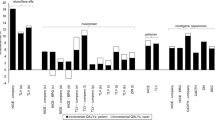Abstract
Background
The EuroQol-5 Dimension (EQ-5D) instrument is the National Institute for Health and Care Excellence (NICE)’s preferred measure of health-related quality of life (QoL) in adults. The three-level (3L) value set is currently recommended for use, but the five-level (5L) set is increasingly being used in practice.
Objective
We aimed to explore the impact of moving from 3L to 5L in NICE appraisals.
Methods
We adapted our existing mapping for use with health state utility values derived from a population where the original distribution of utilities was unknown. We used this mapping to estimate 5L utilities for 21 comparisons of interventions from models used in NICE technology appraisal decision making, covering a range of disease areas.
Results
All utilities increased using 5L, and the differences between highest and lowest utilities decreased. In ten oncology comparisons, using 5L generally increased the incremental quality-adjusted life-years (QALYs) as the benefit from improving survival increased. In four non-oncology comparisons where the intervention improved QoL only, the incremental QALYs decreased as the benefit of improving QoL was reduced. In seven non-oncology comparisons where interventions improved survival and QoL, there was a trade-off between increasing the benefit from survival and decreasing the benefit from improving QoL.
Conclusion
3L and 5L lead to substantially different estimates of incremental QALYs and cost effectiveness. The direction and magnitude of the change is not consistent across case studies. Using 5L instead of 3L may lead to different reimbursement decisions. NICE will face inconsistencies in decision making if it uses 3L and 5L concurrently.




Similar content being viewed by others
References
National Institute for Health and Care Excellence. Guide to the methods of technology appraisal 2013. 2013. https://www.nice.org.uk/process/pmg9/chapter/the-reference-case. Accessed 13 Dec 2017.
National Institute for Health and Care Excellence. Position statement on use of the EQ-5D-5L valuation set. 2017. https://www.nice.org.uk/Media/Default/About/what-we-do/NICE-guidance/NICE-technology-appraisal-guidance/eq5d5l_nice_position_statement.pdf. Accessed 13 Dec 2017.
Janssen MF, Bonsel GJ, Luo N. Is EQ-5D-5L better than EQ-5D-3L? A head-to-head comparison of descriptive systems and value sets from seven countries. Pharmacoeconomics. 2018. https://doi.org/10.1007/s40273-018-0623-8.
Buchholz I, Janssen MF, Kohlmann T, Feng YS. A systematic review of studies comparing the measurement properties of the three-level and five-level versions of the EQ-5D. Pharmacoeconomics. 2018. https://doi.org/10.1007/s40273-018-0642-5.
Hernandez Alava M, Wailoo A, Grimm S, Pudney S, Gomes M, Sadique Z, et al. EQ-5D-5L versus EQ-5D-3L: the impact on cost-effectiveness in the United Kingdom. Value Health. 2017. https://doi.org/10.1016/j.jval.2017.09.004.
Devlin NJ, Shah KK, Feng Y, Mulhern B, van Hout B. Valuing health-related quality of life: an EQ-5D-5L value set for England. Health Econ. 2017. https://doi.org/10.1002/hec.3564.
Dolan P. Modeling valuations for EuroQol health states. Med Care. 1997;35(11):1095–108.
Mulhern B, Feng Y, Shah K, Janssen MF, Herdman M, van Hout B, et al. Comparing the UK EQ-5D-3L and English EQ-5D-5L value sets. Pharmacoeconomics. 2018. https://doi.org/10.1007/s40273-018-0628-3.
Wailoo A, Hernandez Alava M, Grimm S, Pudney S, Gomes M, Sadique Z et al. Comparing the EQ-5D-3L and 5L versions. What are the implications for cost effectiveness estimates? 2017. http://scharr.dept.shef.ac.uk/nicedsu/methods-development/eq-5d-5l/. Accessed 13 Dec 2017.
Hernandez-Alava M, Pudney S. Econometric modelling of multiple self-reports of health states: the switch from EQ-5D-3L to EQ-5D-5L in evaluating drug therapies for rheumatoid arthritis. J Health Econ. 2017;55:139–52. https://doi.org/10.1016/j.jhealeco.2017.06.013.
Hernandez Alava M, Wailoo A, Pudney S. Methods for mapping between the EQ-5D-5L and the 3L for technology appraisal. 2017. https://scharr.dept.shef.ac.uk/nicedsu/methods-development/eq-5d-5l/. Accessed 13 Dec 2017.
Hernández-Alava M, Pudney S. eq5dmap: a command for mapping between EQ-5D-3L and EQ-5D-5L. STATA J. 2018;18(2):395–415.
Felson DT, Smolen JS, Wells G, Zhang B, van Tuyl LH, Funovits J, et al. American College of Rheumatology/European League against Rheumatism provisional definition of remission in rheumatoid arthritis for clinical trials. Ann Rheum Dis. 2011;70(3):404–13. https://doi.org/10.1136/ard.2011.149765.
Brazier J, Roberts J, Tsuchiya A, Busschbach J. A comparison of the EQ-5D and SF-6D across seven patient groups. Health Econ. 2004;13(9):873–84. https://doi.org/10.1002/hec.866.
Gamst-Klaussen T, Chen G, Lamu AN, Olsen JA. Health state utility instruments compared: inquiring into nonlinearity across EQ-5D-5L, SF-6D, HUI-3 and 15D. Qual Life Res. 2016;25(7):1667–78. https://doi.org/10.1007/s11136-015-1212-3.
Konerding U, Moock J, Kohlmann T. The classification systems of the EQ-5D, the HUI II and the SF-6D: what do they have in common? Qual Life Res. 2009;18(9):1249–61. https://doi.org/10.1007/s11136-009-9525-8.
Longworth L, Yang Y, Young T, Mulhern B, Hernandez Alava M, Mukuria C, et al. Use of generic and condition-specific measures of health-related quality of life in NICE decision-making: a systematic review, statistical modelling and survey. Health Technol Assess. 2014;18(9):1–224. https://doi.org/10.3310/hta18090.
Wee HL, Machin D, Loke WC, Li SC, Cheung YB, Luo N, et al. Assessing differences in utility scores: a comparison of four widely used preference-based instruments. Value Health. 2007;10(4):256–65. https://doi.org/10.1111/j.1524-4733.2007.00174.x.
Acknowledgements
The authors thank the FORWARD databank, their patient participants and directors Kaleb Michaud and Fred Wolfe. We also thank the companies who gave permission for their models to be considered as case studies in this report. We acknowledge the contributions of Rosie Lovett, Jacoline Bouvy, Jo Richardson, Janet Robertson, and Sophie Cooper at NICE who suggested case studies for inclusion, facilitated access to models and critically reviewed the analysis.
Author information
Authors and Affiliations
Contributions
Monica Hernandez-Alava and Stephen Pudney developed the mapping algorithm and adapted it for use with mean utility scores. Becky Pennington used the algorithm to map utility scores for the case studies, adapted the models to use the 5L utilities and analysed the results. Allan Wailoo conceived the idea for the analysis and provided suggestions and critique of the approach. Becky Pennington drafted the first version of the manuscript, which all authors reviewed and made changes to. All authors reviewed and approved the final manuscript.
Corresponding author
Ethics declarations
Conflict of interest
Becky Pennington, Monica Hernandez-Alava, Stephen Pudney and Allan Wailoo have no conflicts of interest.
Rights and permissions
About this article
Cite this article
Pennington, B., Hernandez-Alava, M., Pudney, S. et al. The Impact of Moving from EQ-5D-3L to -5L in NICE Technology Appraisals. PharmacoEconomics 37, 75–84 (2019). https://doi.org/10.1007/s40273-018-0701-y
Published:
Issue Date:
DOI: https://doi.org/10.1007/s40273-018-0701-y




